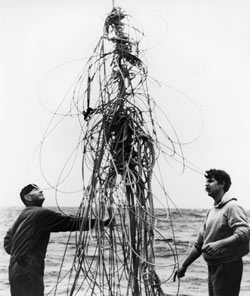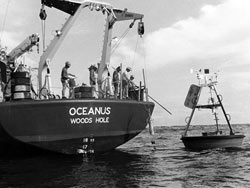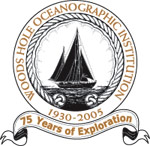This is an archived site. This site is no longer being maintained or reviewed for broken links.
Down to the Sea for Science – Science Feature
Earth’s Greatest Interface: A Short History of Air-Sea Interaction Research at WHOI
 |
|
|
When things went wrong in the early days of developing moored-instrument technology, the only return might be a “wuzzle,” like this one being retrieved by Jim Gifford, left, and Bob Heinmiller in the late 1960s. However, the persistence of the WHOI Buoy Group paid off. (Photo courtesy WHOI Buoy Project) |
|
 |
|
|
The 1982–84 Long-Term Upper Ocean Study (LOTUS) brought home two years’ worth of atmospheric and upper-ocean measurements, the first long-term time series for this type of data. In the photo, the surface mooring has been launched, and the first of a string of current meters to be deployed beneath it is about to go in the water. (Photo by Mel Briscoe) |
The vast interface of ocean and atmosphere constitutes one of the earth’s great interactive engines. WHOI scientists have long investigated upper-ocean and atmospheric processes and their influences on one another. Observation of air-sea interaction began with Al Woodcock, a member of the very first Atlantis crew, who migrated to science and, during long days at sea, noted similarities in the patterns of seabird flight and the array of seaweed as it aligned with the wind on the surface of the Sargasso Sea.
Woodcock studied low-altitude turbulence and convection and their impact on smoke screens intended to aid troop landings during World War II. Later he was a principal in postwar investigations of air-sea exchanges of heat and moisture in trade-wind areas as well as the study of salt particles as nuclei for raindrops. Woodcock, Andy Bunker, Joanne Malkus (Simpson), and others developed instrumentation for a succession of WHOI-based aircraft devoted to marine meteorology from 1945 to 1970.
Development of moored surface buoys, an extremely difficult task because of the effect of surface motion on mooring components, was pursued with vigor at WHOI during the 1960s and 1970s. Successful mooring efforts gradually overcame the disappointing failures, and the first long-term (two-year) time series of data on atmospheric forcing and upper-ocean response was achieved in the Long-Term Upper Ocean Study east of the Gulf Stream off Cape Hatteras from 1982 to 1984. With further improvements in measuring devices and mooring technology, WHOI researchers took on new challenges in the tropical Pacific and the Arabian Sea while also developing more capable atmospheric, oceanic, and coupled numerical models.
Other tools used for Institution air-sea research include towers built along the shore, on islands, aboard ships, and in shallow waters, including one built in 2000 at WHOI’s Martha’s Vineyard Coastal Observatory. In another approach, small catamarans bristling with instruments are sent out from ships in the open ocean to avoid ship-based contamination of measurements.
Today WHOI researchers are world leaders in air-sea observations, surface mooring technology, upper-ocean dynamics, and the ocean’s role in climate, and they look forward to continuing their pioneering work in air-sea interaction in future decades.
This feature is based on an unpublished 2004 manuscript entitled “WHOI Air-Sea Interaction” by Robert A. Weller, WHOI senior scientist and director of the NOAA/WHOI Cooperative Institute for Climate and Ocean Research.

